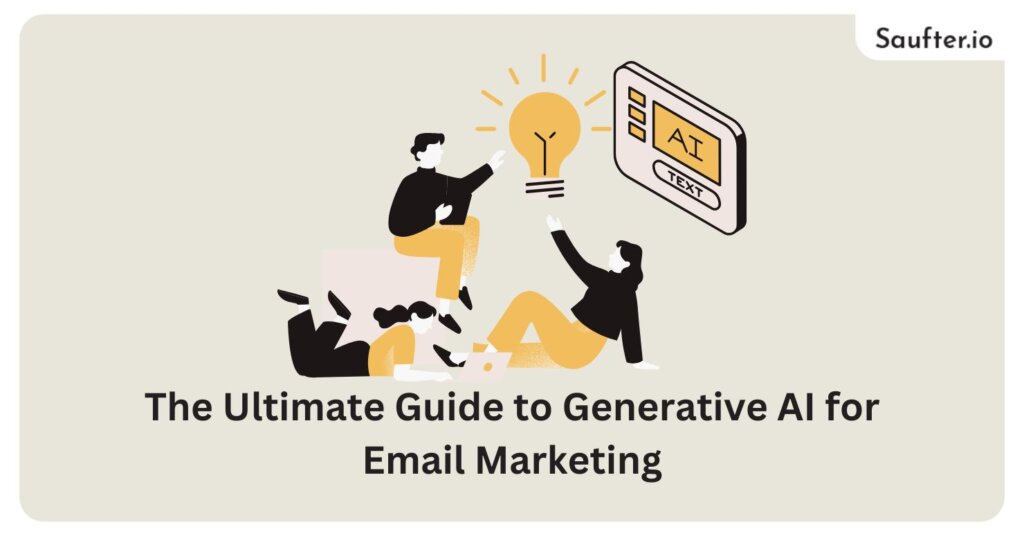Last Updated: January 2026
In today’s fast-paced digital landscape, generative AI for email marketing is transforming how businesses connect with their audiences. With personalized emails driving up to 6 times higher transaction rates than generic ones, the need for smarter, faster, and more impactful campaigns has never been greater.
Generative AI empowers marketers to craft tailored email content, optimize subject lines, and even predict the best times to send—all while saving time and boosting efficiency.
This guide will walk you through everything you need to know about using generative AI for email marketing, its benefits, and actionable strategies to elevate your campaigns and achieve better results.
What is Generative AI for Email Marketing?
Generative AI for email marketing uses cutting-edge AI technology to create personalized, engaging, and high-performing email copy to suit specific campaigns.
This advanced tech allows advertising professionals to cut conversational and appropriate messages at scale, supporting a business tone of voice. Studies show marketers employing AI see up to 41% higher click-through rates on email campaigns than traditional methods.
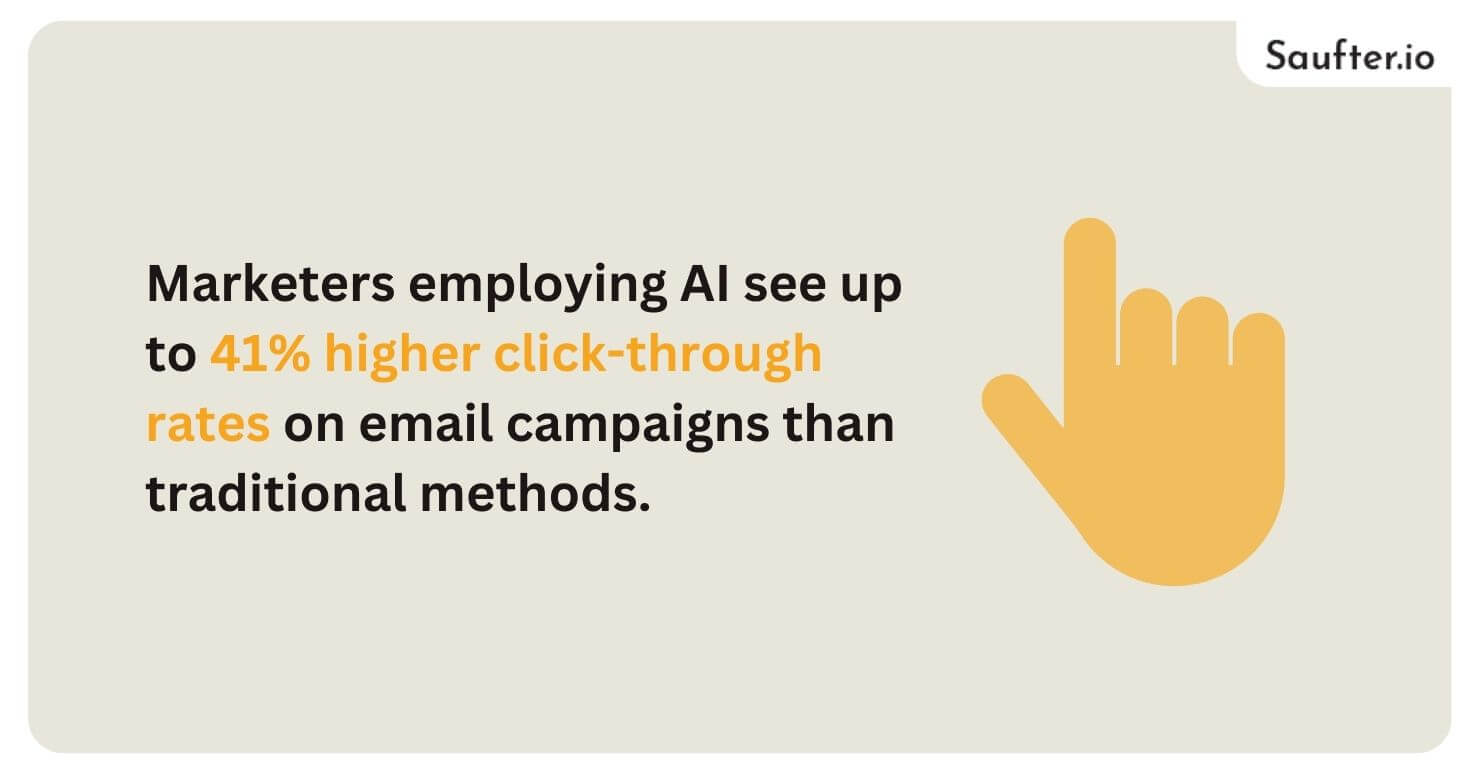
The Composition of Creativity and Technology
Crafting a compelling email message is a combination of art and science. For one side, a solid understanding of the brand itself, target audience, and campaign goals is essential to effective social media marketing.
On the other side, it leverages Generative AI’s capacity to mine large datasets, spot patterns, and create high-quality content. It enables companies to pull together their messaging without the tediousness and manual labour of being human.
The Power of Prompts
The building blocks of generative AI in email marketing are known as “prompts,” which are instructions that guide AI to generate content. These prompts can include anything from terse keywords to elaborated descriptors that guide the AI to orient its output to the goals of the campaign.
For example, a brand promoting a new product might provide a prompt like:
“Write an engaging email introducing our new customizable sneakers, highlighting their unique features, and encouraging readers to make a purchase.”
The AI analyzes the input and generates a draft email intended to communicate the message, highlight the product’s advantages and encourage action.
Gen-AI enables marketers to harness the power of AI while still adding their own creative insight. Hence, revolutionizing email campaign strategies and building a powerful new resource for personalized content.
4 Key Benefits of Generative AI for Email Marketing
With advanced solutions to personalize campaigns, ensure brand consistency, and increase conversions, generative AI is revolutionizing email marketing.
It empowers businesses to engage more effectively with their target markets through the delivery of personalized content at scale and advanced testing to fine-tune strategies. This is how Generative AI is changing email marketing.
1. Personalization at Scale: Delivering Tailored Content Effortlessly
One of the most powerful benefits of Generative AI for email marketing is personalization. Instead of sending out the same message to everyone, Generative AI can seal them to be personalized for specific segments.
Whether you’re speaking to an existing customer, someone considering a purchase or a first-time visitor, Generative AI can instantly craft copy tailored to each segment. Adding new experiences without increasing your workload.
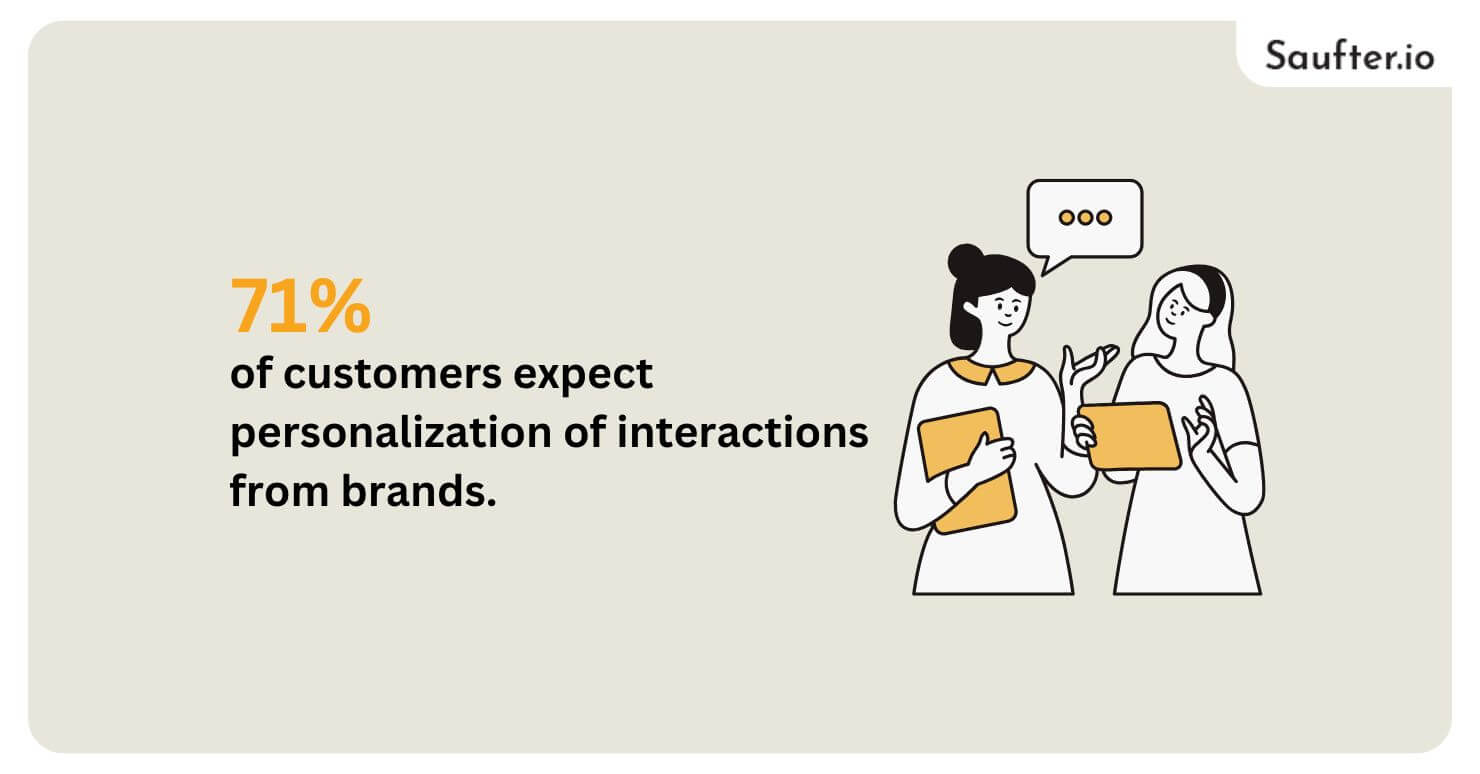
It leads to more relevant experiences for even more customers and ultimately drives meaningful engagement and stronger brand connections. As per a study by McKinsey, 71% of customers expect personalization of interactions from brands, therefore the need for Generative AI to meet the demand becomes more important.
2. Consistency in Brand Voice: Enhancing Trust and Recognition
A consistent brand voice is vital for establishing trust and a strong brand identity. When paired with a human touch, Generative AI guarantees that all the email content is consistent with your brand’s tone and style guidelines.
This is really helpful when there are multiple contributors on teams building email campaigns. Generative AI acts as a safeguard, preventing deviations from established brand messaging while enabling seamless collaboration. It helps brands be recognisable and resonate with the audience.
3. Boosting Conversions with Optimized Messaging
The ultimate goal of email marketing isn’t just reaching inboxes—it’s driving action. Generative AI excels at creating compelling subject lines, engaging body copy, and persuasive CTAs that maximize conversions.
Tools powered by artificial intelligence like Saufter help marketers look past the usual standards such as open rates and instead focus on the language that drives action and delivers measurable results. From creating curiosity in a subject line to driving clicks through persuasive messaging, Generative AI helps brands deliver higher engagement and conversion rates.
4. Enhanced Testing and Insights: Perfecting Campaign Strategies
While A/B testing has always been part of email marketing, Generative AI moves it up a notch. While brands can quickly generate lots of versions of emails, multivariate testing becomes easier and more extensive.
Multivariate testing is different in that, unlike A/B tests, which test one or two elements (like subject lines or CTAs), brands can experiment with combinations of multiple kinds of elements (like: delivery times, images, CTAs, body copy).
For instance, a single campaign can test different subject lines, visual elements, and messaging to identify the most effective combination.
Generative AI Marketing Use Cases
Generative AI is revolutionizing email marketing for brands by helping them deliver the most meaningful and relevant emails at the most effective time with the same tone and style of their written material.
Machine learning in marketing also automates the process of creating campaigns and audience engagement like never before using complex algorithms.
1. Text or Content Generation for Emails
The technology automates the generation of the content of emails using natural language processing (NLP) and large language models. These tools analyze huge datasets to write captivating and pertinent messages that connect with audiences. Key applications include:
- Promotional Content: Create unique and engaging copy for the email campaigns special offers, announcements, and seasonal marketing campaigns.
- Automated Follow-Ups: Develop concise and personalized follow-up sequences to nurture leads and maintain customer engagement.
2. AI Email Subject Line Generator
Generating subject lines for emails is one of the most influential uses of generative AI in email marketing. AI tools can analyze user behavior, campaign goals, and industry trends to create effective-generating subject lines that:
- Capture attention instantly.
- Improve open rates through personalized and engaging wording.
- Align with the tone and intent of the email content.
3. Visual Content Generation for Emails
Deep learning and generative adversarial networks (GANs) in generative AI also improve the visual components of email campaigns. This ability allows marketers to:
- Create Engaging Product Visuals: Create high-quality images that look real for use in promotional emails to sell whatever products are needed.
- Design Custom Graphics: Create custom, on-brand visuals, such as headers, banners, and logos for email templates.
- Video Content Integration: AI-generated video snippets (e.g., product demonstrations or personalized messages) can be integrated into emails to boost click-through rates.
Limitations of Generative AI
While generative AI saves time and helps marketers create email content quickly and easily, several risks can arise from it, and marketers should know this.
1. Security and Privacy Concerns
Vast online data is available for generative AI use, but ensuring ethical use is difficult. It could misuse confidential or non-permissioned information, which could lead to data breaches and open itself to legal consequences. Misuse of AI, including for surveillance, compounds the dangers.
2. Inaccuracy of Information
AI’s data pool comes from diverse sources, some of which can contain stale or inaccurate information. This can lead to the dissemination of incorrect information and result in misunderstandings and damage to the brand’s credibility.
3. Lack of Human Connection
AI-generated emails sound robotic or impersonal because of the absence of an emotional tone that inspires trust. It can decrease engagement and lead to less effective communication.
4. Risk of Spam Classification
Emails generated by AI can also seem cheesy or robotic, tripping spam filters. Malicious entities can also use AI for phishing, and duplicate content can drive away receivers.
While generative AI helps improve efficiency, solving these risks is necessary to keep trust, accuracy, and security in email marketing.
Best Practices for Using Generative AI in Email Marketing
Adding Generative AI to your email marketing mix is a surefire way to enhance efficiency and personalization. A staggering 91% of consumers indicated that they are more likely to shop with brands that provide relevant offers and recommendations, making it an absolutely necessity to begin leveraging the power of AI to meet these demands.
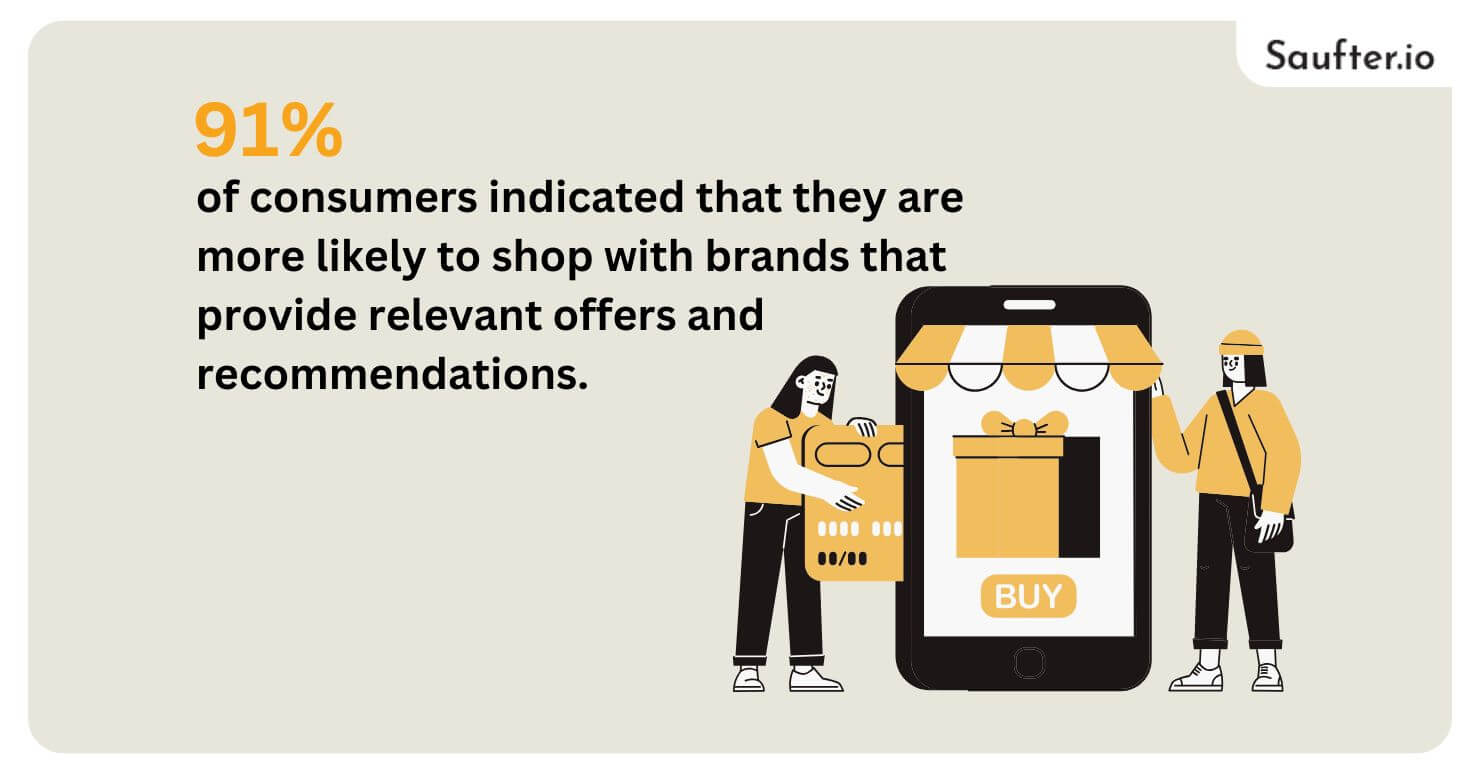
But its success relies heavily on how well you leverage it. Follow these best practices to maximize the potential of Generative AI in your campaigns:
1. Define Clear Objectives
Define, before you use Generative AI, the precise objectives of your campaigns. Do you want to drive sales, engagement, traffic or anything else?
Defining what success looks like gives the AI something to strive for and sets clear, measurable goals around how it can be considered successful.
2. Understand Your Audience
Generative AI excels when you feed it insights about your audience. Segment your audience with customer data, and develop very specific buyer personas. You can analyze their preferences, behaviors and pain points to steer AI to produce content that resonates with each audience segment.
3. Craft Precise Prompts
The quality of AI-generated content depends on the prompts you provide. Be specific and detailed when crafting prompts to align the AI’s output with your campaign goals. For example, instead of “Create a promotional email,” use “Write a promotional email for our new eco-friendly product, highlighting its unique features and including a limited-time discount offer.”
4. Maintain Brand Consistency
The quality of the output always relies on the prompts you give. Craft prompts that are specific and detailed enough to help the AI understand how to align its output with what you hope to achieve in your campaign.
If you’d like to “Create a promotional email,” try “Write a promotional email for our new eco-friendly product, emphasizing its unique features and including a limited-time discount offer.”
5. Utilize A/B and Multivariate Testing
Use Generative AI’s capability of producing multiple iterations of your content for testing. Use A/B tests to evaluate two or more forms of subject lines, CTAs, or visuals.
For even more optimization, multivariate testing can be employed to analyze several elements of a campaign at once.
6. Emphasize Personalization
The scalability of generative AI provides a powerful tool for personalization. This allows for the creation of more compelling experiences by personalizing content per audience segment. These could include product suggestions based on past browsing behavior or special discounts in line with purchase history.
7. Respect Privacy and Regulations
Adhere to data privacy laws such as GDPR, CCPA, and the CAN-SPAM Act. Always obtain proper consent to send emails and provide clear opt-out options for subscribers. Generative AI should be used responsibly to maintain trust and comply with ethical marketing practices.
8. Incorporate the Human Touch
Generative AI will be an incredibly powerful tool but works best with human expertise. Take a step back and review what the AI tool generates to verify that it accurately fits your brand voice, campaign messaging, and nuances. The human touch can streamline AI’s output to resonate with your audience.
9. Stay Agile and Adapt
The world of digital marketing is rapidly changing, indeed everything happening around Generative AI technologies is new. Keep up with AI progress, and keep adjusting your strategies for fresh, effective campaigns.
Saufter: Best Email Marketing Automation Software

Saufter is a powerful customer engagement and email marketing platform designed to analyze user behavior on your website or portal, as well as their journey stages, to provide tailored campaign recommendations.
For instance, Saufter might suggest a “how-to” article for a feature a user hasn’t explored yet. It delivers fully drafted email and in-app campaigns to you weekly, leaving you with the simple task of approving them.
Additionally, Saufter monitors your competitors’ activity and recommends content campaigns inspired by their latest blog posts.
Key features include:
- Automated segmentation of users into cohorts based on behavior
- Automated email campaign recommendations to boost conversions and reduce churn
- Automated SEO campaign suggestions
- Automated predictions for conversion rates and churn prevention
Conclusion
In conclusion, generative AI for email marketing is revolutionizing how businesses engage with their audiences, offering smarter, faster, and more personalized campaigns. Platforms like Saufter make it easy to automate key tasks, from user segmentation to campaign creation, helping marketers save time and achieve better results.
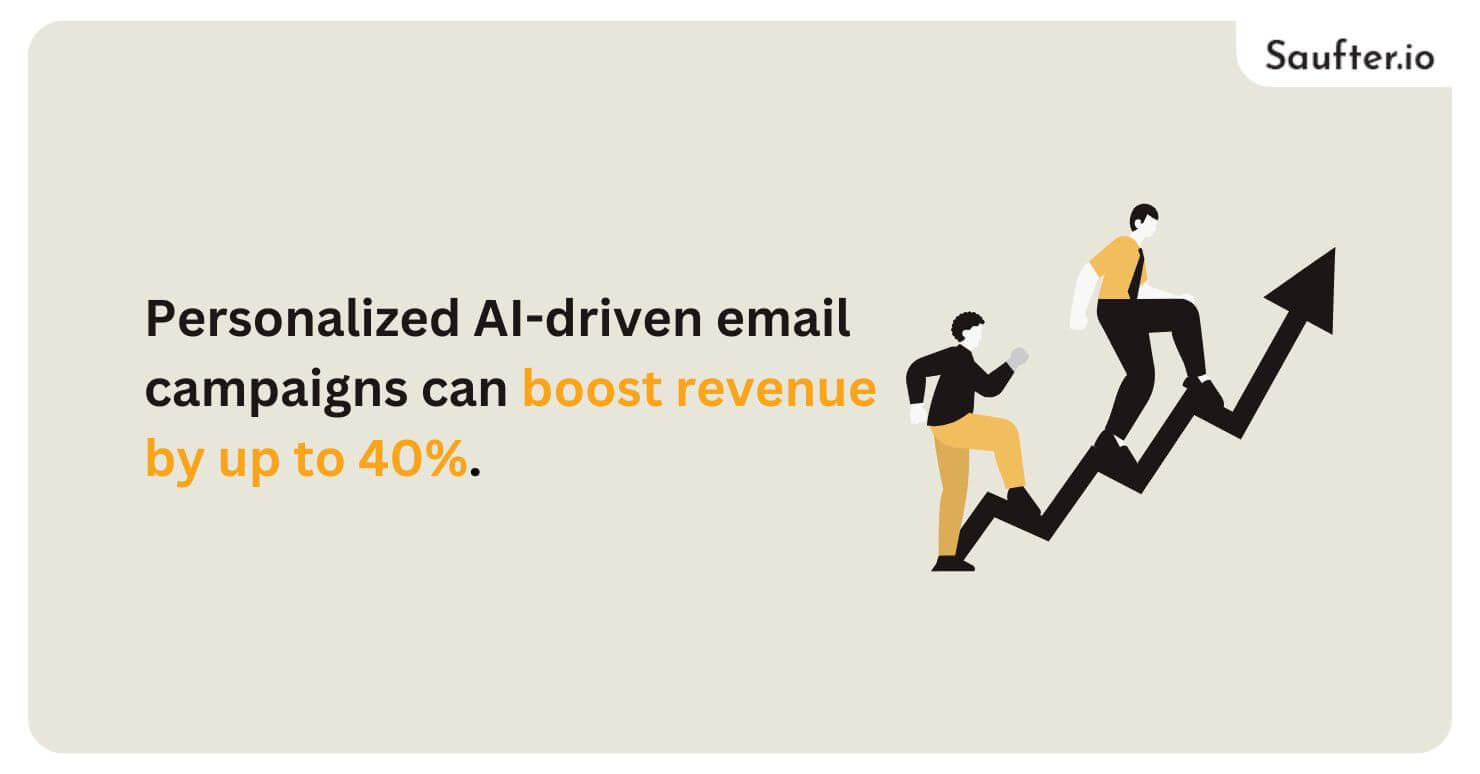
Research shows that personalized AI-driven email campaigns can boost revenue by up to 40%, proving the value of embracing this technology. As the digital landscape evolves, adopting generative AI for email marketing is essential for staying competitive and building deeper connections with your audience. Explore tools like Saufter to start transforming your email marketing strategy today!
